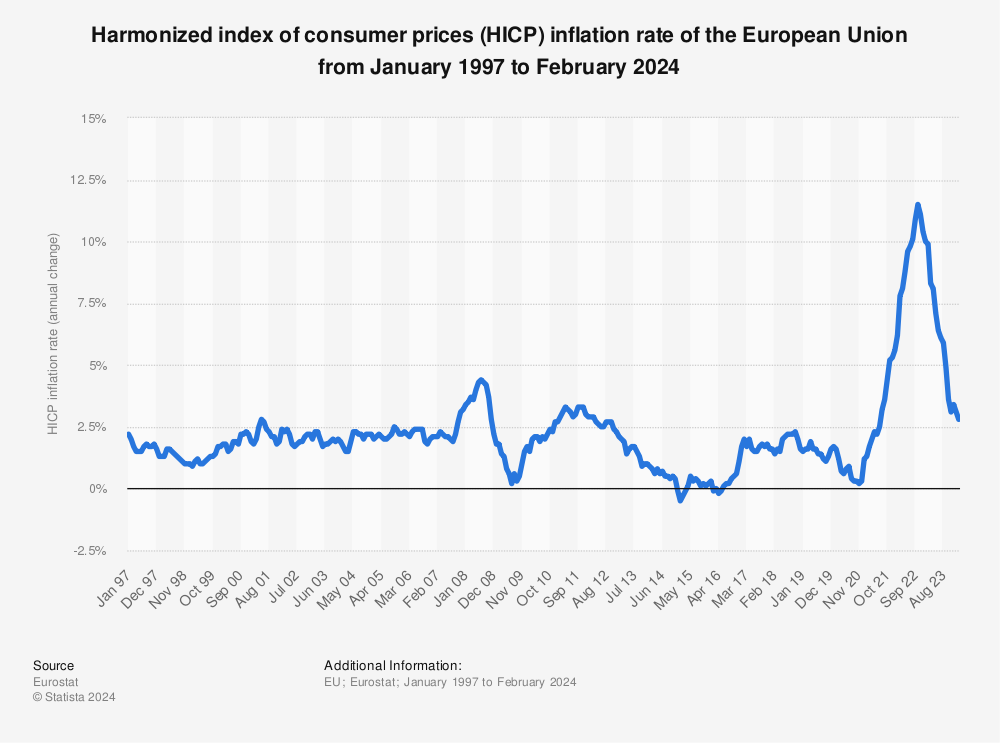How to Set the Right Prices for Your E-commerce during High Inflation Rates
19/09/22
6'
Inflation has been affecting global economies at an accelerating speed as prices are higher than in the previous decades in most sectors. In the European Union, for instance, in July 2022 the inflation rate reached 9.8%, while just one year before the same month registered an inflation of 2.5%. Among all EU countries Estonia had the highest inflation rate in July 2022 at 23.2% and France the lowest with 6.8%.

Find more statistics at Statista
What does this mean for consumers and businesses? In short: For buyers it means having to tighten up their belts, for businesses to be on the horns of a dilemma.
Pricing is key for companies, as it determines whether they overcome this economic obstacle or not. If companies decide to raise their prices, their customers might choose competitors instead, but if they decrease or maintain their current prices, their revenue might decrease as well. Since it is impossible to keep up with all the price changes manually, big marketplaces, like Amazon, are using dynamic pricing to adjust prices several times a day and reacting to competitor prices in just one hour.
In this blog post we will take a deeper look into the context of today’s inflation and explain why more than ever e-commerce businesses need price intelligence solutions to set the right prices.
What is causing high inflation?
The reasons behind the rise of inflation are multiple, however, in order to understand the current inflationary situation, we have to take a step back and look at the most prominent factors.
- Lack of goods: One of the main contributors is the Covid-19 pandemic, which created obstacles for retailers and brands who relied on raw materials, like wood and plastic, and finished goods that were either not shipped at all or if so, for a very high price and at a slow pace.
- High demand: These supply-chain shortages were reinforced by the increased consumer demand after the pandemic. During lockdown people spent less and saved more, whereas once the lockdown was lifted consumers started spending more again. This consumer behaviour aggravated the inflation rate, as there was a sudden influx of money but less goods being produced.
- High supply costs: In addition, this year the war in Ukraine also affected the international markets, since many countries closed their access to Russian gas and oil, leading to fossil fuels prices going up across Europe and automatically affecting the prices of products across different sectors, due to rising production and transportation costs.
Understand your audience to succeed
As with most issues, there is not just one right way of dealing with high inflation as a business. Depending on the sector, size and type of business high inflation may affect you less or more, and therefore, the solutions must be personalised.
Since buyers are now worried about their spendings, as they aren’t able to afford the same products as in pre-pandemic years, businesses must think twice before setting up prices.
According to a study by the comparative website idealo.es, 52% of Spaniards say they cannot make ends meet due to the current economic crisis.This has forced people in Spain to reduce their purchases mainly in the electronics (45%) and fashion sector (clothing = 37%, shoes = 35%), which are usually amongst the top online shopping sectors.
In such difficult times for consumers, when prices are skyrocketing, products from these industries are not perceived as essential goods, which is why businesses have to set attractive prices and be creative to keep afloat. Furthermore, it has become essential for buyers to compare prices online to find the best deals they can get, which mostly happens on marketplaces. Around half of all product searches online start in a marketplace, which is why retailers should invest in selling their products there as well.
Worried about your pricing? Here’s what you can do
As mentioned previously, the challenge as a business when facing high inflation is to find the right balance between profit and customer satisfaction. You have to set prices that both benefit your business but don’t scare away customers, therefore they shouldn’t be either too high, nor too low.
In today’s inflationary environment there are some key aspects to keep in mind:
- Targeted pricing strategy: There are many pricing strategies to choose from but with high inflation comes the need to adapt prices to each product and each customer segment. Although the costs of your supplies may be rising, that doesn’t necessarily mean that all your product prices should increase.
- Effective communication: In case you do need to increase your prices make sure to effectively communicate the reasons behind your decision, as this also affects the lives of your customers, who are equally affected by the inflation. It is recommended that companies adopt a consumer-centric thinking and base their conversation around the value of product-specific attributes.
- Market overview: No matter how well you think your pricing strategy is, if your competitors are selling more under the same circumstances as you, it might be due to their pricing. Make sure you monitor the prices of your competition to increase your market share.
But, how can you know the ideal price for your products? And how can you make sure that your competitors don’t get ahead of you?
Since it has become impossible for e-commerce businesses to monitor their competitor’s prices manually, the solution is to use a dynamic pricing solution. This software allows you to have control over your market and reprice your products according to real-time data. Thanks to a dynamic pricing solution you can protect your profit margin and still stand out from the competition. In addition, you will be able to define your own pricing rules and get notified when your competitors have out-of-stock products or have changed their prices.
Lengow x Netrivals for Brands
All the market and price intelligence you need to thrive in the Commer…
Learn moreHow Lengow can help your business get the right price during inflation
Inflation is a hot topic at the moment for a good reason: Individuals are struggling with ongoing rising living costs and companies are pressured by the inflationary costs and by their customers’ expectations. At Lengow you have the possibility to not only overcome this troubled situation, but also grow your business thanks to our many digital solutions.
With the latest acquisition of Netrivals, you can now have total control over your market and precise real-time data from over 32k online stores, which will help you offer competitive prices at all times.
Lastly, Lengow helps to promote your products after defining the right prices thanks to our marketplace and marketing solutions, which are equally necessary in order to guarantee your presence on all online shopping spots in an automated way.
Photo: Kattecat (Shutterstock)
Your e-commerce library
E-commerce for Retailers
Learn moreE-commerce for Brands
Learn moreL'Oréal Luxe Success Story
Learn moreSign up for our newsletter
By submitting this form you authorize Lengow to process your data for the purpose of sending you Lengow newsletters . You have the right to access, rectify and delete this data, to oppose its processing, to limit its use, to render it portable and to define the guidelines relating to its fate in the event of death. You can exercise these rights at any time by writing to dpo@lengow.com

Trending Posts
Marketing channels
Where does Gen Z shop online?
Gen Z online shopping is transforming the digital marketplace, setting trends that redefine what it means to engage with brands…
16/04/24
9'
Marketplaces
The Top 10 Marketplaces in Europe
The e-commerce scene is a vibrant mix of marketplaces in Europe. These aren't just websites; they're bustling hubs where millions…
08/12/23
7'
Marketplaces
Lengow Now Fully Supports Zalando Logistics Solutions ZSS and ZRS
Zalando, one of Europe’s leading fashion marketplaces, continues to raise the bar with its advanced logistics and fulfillment programs. After…
12/12/24
4'
Marketplaces
How to win the Buy Box on Marketplaces (Amazon, Zalando, etc.)
What is the most important thing for marketplace sellers? Exactly, the Buy Box! If you don't have the Buy Box…
02/04/24
10'
Marketplaces
How to Sell on Temu? Best Tips
Emerging under the vast umbrella of PDD Holdings Inc., Temu has skyrocketed in popularity as a shopping sensation from China…
17/08/23
5'





